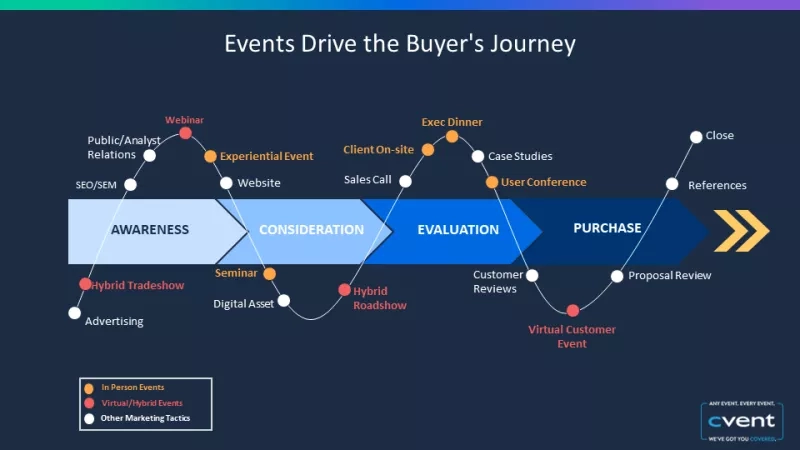It's time to think differently about events. For marketers, events have become an essential marketing channel to build brand, drive demand and generate leads. Not only that, but events are experiencing a digital transformation, accelerated by the two years of virtual and hybrid events that dominated during the pandemic.
Contents
This digitisation of events, combined with an evolving event technology landscape, presents marketers with a golden opportunity for audience expansion, enhanced insights, greater engagement, plus more effective lead and revenue generation.
Why should your marketing mix include events?
74% of marketers say that events are their most important demand generation tactic, according to Forrester research.
This is no surprise: events not only provide a valuable opportunity for marketers to form deeper audience connections, they also allow for the curation of more personalised experiences both online and in-person.
More digital and data touchpoints
In-person events, which before the pandemic were often considered hard to quantify and measure, are now underpinned by technology, which increases the number of digital touchpoints.
These touchpoints provide more data insights than other marketing channels - giving brands a more complete picture of this extended customer journey.
Increased engagement
Events with an increased number of digital touchpoints also drive deeper engagement.
Polls, Q&A, surveys and gamification, managed via a mobile event app, help audiences to feel more involved with your event content, while providing key insights into who engaged with what elements. The more someone engages, the more invested they are in your product or service, which could make them an ideal candidate for post-event follow-up.
Reaching new audiences
These more digitised events can reach new audiences who may have otherwise not been able to travel to a purely in-person occasion and allow marketers to package an event’s content in a variety of ways.
Driving pipeline and revenue
By combining in-person, virtual, and hybrid events, brands can nurture leads at every stage of the funnel, moving prospects further down the buyer journey to purchase. Additionally, making content available on-demand and using it as part of future campaigns and event promotions can drive pipeline (by analysing engagement and building audience profiles).
How to set event marketing goals
Before you can reap the benefits of this new event marketing opportunity, you need to set goals based on your campaign objectives - whether that’s driving brand awareness, lead generation, customer retention or advocacy.
Some useful KPIs to measure include:
- Increases in event registrations
- Attendee satisfaction scores
- Attendee engagement
- Brand mentions across social and other media channels
- The number of customer leads or sales generated.
While contributing to a sales pipeline or revenue bottom line may be the ultimate marketing goal, focusing on attendee engagement and satisfaction can produce wide-ranging benefits.
A highly satisfied conference attendee for example, will more likely become a future customer, return to subsequent events or be retained as a customer.
Meanwhile, tracking brand awareness and brand mentions can indicate engagement across your events—from product launches and roadshows to field marketing and event sponsorship.
Event marketing strategy tips
1) Map your events to the buyer journey
Whether hybrid, virtual or in-person, don’t limit your events to one stage of the customer journey. The beauty of events is that they can influence every stage, depending on your goals.
For example, you can nurture leads from awareness to consideration through both experiential brand activation (where the consumer gets to touch, feel and experience the product) and through virtual events, where you can bring together industry experts and thought leaders to discuss trends in order to position your brand as an authoritative voice.
Once prospects have been converted into customers, you can use a range of event formats to build community and advocacy. For example, you could host user conferences to educate customers on your additional product offerings or hold virtual customer webinars to deliver training or receive valuable user feedback.
2) Be audience-centric
Consider the data-capture possibilities at each step of the event experience and you’ll quickly find there’s ways to build out comprehensive profiles of your audience, often in very subtle ways without demanding reams of information.
Data profiles about your audience can be created both from a macro level of understanding trends and averages, and on a per-person basis - creating fuller profiles of each of your individual attendees.
The wider, macro level can be used as a “temperature gauge” to position the brand or get a better understanding of attendee interests. While individual profiling is useful for tailoring content and providing a more personalised event experience.
3) Include digital touchpoints in your in-person events
Adding digital elements to your in-person events will increase the reach of your event, help you to build community, grow advocacy and gather valuable data on attendee interactions.
You can use voting polls, engagement analytics and other digital touchpoints via a mobile event app to see who is interacting with which speakers, who is showing genuine interest and who is therefore ripe for follow-up.
A mobile app further helps to provide an online audience with the same audience interaction functionality as the in-room attendees. By ensuring that all polls and speaker questions are submitted through the app, you can remove any chance of audience bias and create a joined-up experience for hybrid events.
4) Make event technology work harder for you
Having the right event technology is key to getting the most out of the benefits that events provide.
According to Forrester, 57% of marketers were looking to increase their investment on event technology in 2022. This wasn’t simply to support virtual events - it was also to support the drive for more digital interactions at in-person events.
Meanwhile, a study in March from the CMO Council, a global network for chief marketing officers, cited the top three digital components that marketers planned to add to in-person events this year.
These digital components were: online platforms (both web and mobile), on-demand content and connecting digital and in-person audiences. All three lead to richer attendee profiling and ROI measurement, better digital content delivery, deeper engagement and better outcomes.
By making event technology work harder for your marketing goals, you can assess performance across your entire events programme and mine richer audience insights and behavioural trends than ever before.
Embrace the new event marketing opportunity
With real-time insights, extended reach and stronger one-on-one connections with customers and prospects, events are a powerful tool within your marketing mix.
Incorporating digital elements into your events and leveraging the available technology will allow you to capture valuable data, drive engagement and ultimately prove ROI.
To find out more about integrating marketing methodologies into your events channel and how technology can help this new event marketing opportunity download our ebook today.







